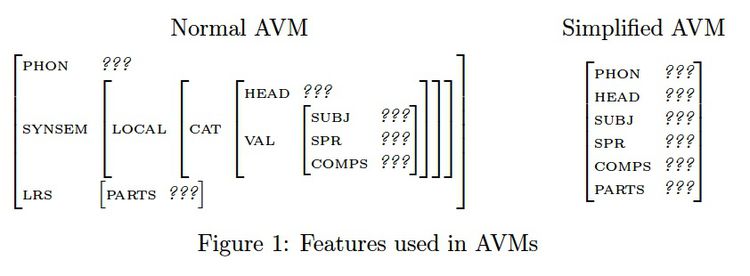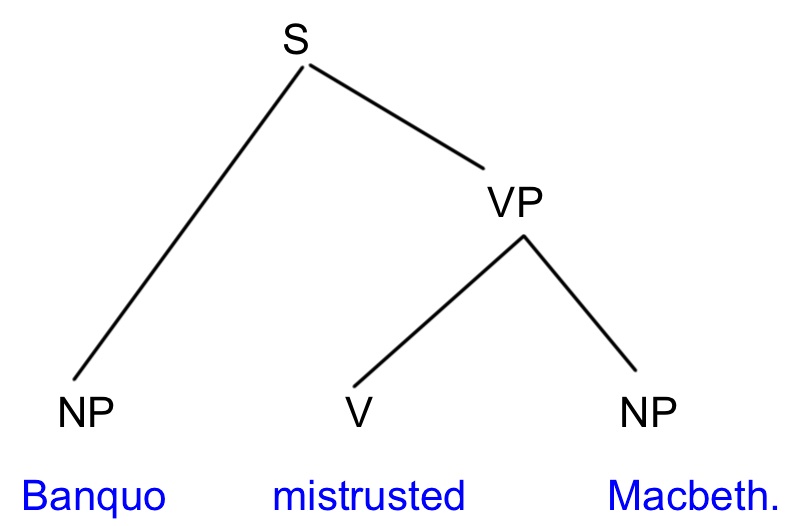Semantics 1, SoSe 2014: Mock exam
Mock exam file: File:Mock-exam-sose14.pdf
The examples in the text are based on Shakespeare's play Macbeth. The full text of the play is available on Projekt Gutenberg.
Task 1: Ambiguity
Consider the following ambiguous sentences.
- For each of these, determine the type of ambiguity.
- Provide an unambiguous paraphrase for the possible readings.
(1) a. Duncan trusted Macbeth because he was a thane.
Check your answer
- Type of ambiguity: referential ambiguity
- Reading 1: he refers to Macbeth. Paraphrase: Duncan trusted Macbeth because Macbeth was a thane.
Reading 2: he refers to Duncan. Paraphrase: Duncan trusted Macbeth because Duncan was a thane.
b. Every king trusts a thane.
Check your answer
- Type of ambiguity: scope ambiguity
- Reading 1: every takes scope over a. Paraphrase: For every king there is at least one thane such that the king trusts that thane.
Reading 2: a takes scope over every. Paraphrase: There is one particular thane such that each king trusts this thane.
b. Macbeth and Macduff are married.
Check your answer
- Type of ambiguity: collective-distributive ambiguity
- Reading 1: collective reading. Paraphrase: Macbeth and Macduff are married to each other
Reading 2: distributive reading. Paraphrase: Macbeth and Macduff are both married, but not to each other.
b. Macbeth killed a king with a dagger.
Check your answer
- Type of ambiguity: structural ambiguity
- Reading 1: the PP with a dagger is a modifier of the verb kill Paraphrase: Macbeth used a dagger to kill a king.
Reading 2: the PP with a dagger is a modifier of the noun king. Paraphrase: Macbeth killed a king who had a dagger.
Task 2: Model and Interpretation
(Note: For this task you do not need to use the functional notation and the types)
1. Define a universe that consists of Macbeth and Banquo.
Check your answer
U = { Macbeth, Banquo }
2. Define the interpretation of the names macbeth and banquo in an intuitively plausible way.
Check your answer
I(macbeth) = Macbeth,
I(banquo) = Banquo
3. Define the interpretation of the properties thane, king, and witch is such a way that Macbeth is a king, both are thanes and neither is a witch.
Check your answer
I(thane) = {Macbeth, Banquo},
I(king) = {Macbeth},
I(witch) = {}
4. Define the interpretation of the 2-place relations mistrust and kill in such a way that Macbeth and Banquo mistrust each other and Macbeth kills Banquo.
Check your answer
I(mistrust) = {<Macbeth, Banquo>, <Banquo, Mactbeth>},
I(kill) = {<Macbeth,Banquo>}
Task 3: Formulae
Write down logical formulae that express the meaning of the following sentences.
1. Banquo is a thane.
Check your answer
thane(banquo)
2. Macbeth is king and Macbeth mistrusts Banquo.
Check your answer
king(macbeth) ∧ mistrust(macbeth,banquo)
3. If Banquo is king then Macbeth does not kill Banquo.
Check your answer
king(banquo) ⊃ ¬ kill(macbeth,banquo)
Task 4: Interpreting formulae
Compute the interpretation of the following formulæ step by step.
1. mistrust(macbeth,macbeth)
Check your answer
[[mistrust(macbeth,macbeth)]] = 1
iff < [[macbeth]], [[macbeth]] > is in [[mistrust]]
iff < I(macbeth), I(macbeth) > in I(mistrust)
iff < Macbeth, Macbeth > in { <x,y> | x mistrusts y } = { <Macbeth, Banquo>, <Banquo, Macbeth> }
Since this is not the case, [[mistrust(macbeth,macbeth)]] = 0.
2. ¬king(banquo)
Check your answer
[[¬ king(banquo)]] = 1
iff [[king(banquo)]] = 0
iff < [[banquo]]> is not in [[king]]
iff < I(banquo> is not in I(king)
iff < Banquo > is not in { <x> | x is king } = { <Macbeth>}
Since this is the case, [[¬ king(banquo)]] = 1
3. witch(banquo) ⊃ king(macbeth))
Check your answer
[[witch(banquo) ⊃ king(macbeth))]] = 1
iff [[witch(banquo)]] = 0 or [[king(macbeth) = 1
iff < [[banquo]] > is not in [[witch]] or < [[macbeth]] > is in [[king]]
iff < I(banquo) > is not in I(witch) or < I(macbeth) > is in I(king)
iff < Banquo > is not in { <x> | x is a witch} = { } or < Macbeth > is in { <x> | x is king} = { <Macbeth>}.
Since both are the case, [[witch(banquo) ⊃ king(macbeth))]] = 1.
Task 5: Variables
Provide a g-function that maps the variables x, y, and z to individuals from the universe and compute the interpretation of the following formula with respect to the model and your g.
(i) kill(z,x)
Check your answer
Example solution (other values for g are equally possible).
g(x) = Macbeth,
g(y) = Banquo,
g(z) = Banquo.
With this variable assignment we can compute the truth value of the formula:
[[kill(z,x)]]g = 1
iff < [[z]]g, [[x]]g > is in [[kill]]g
iff < g(z), g(x) > is in I(kill)
iff < Banquo, Macbeth > is in { <x,y> | x killed y} = { <Macbeth, Banquo> }.
Since this is not the case, [[kill(z,x)]]g = 0.
Task 6: Quantifiers
Provide logical formulae that expresse the meaning of the following sentences. Are the formulae true in your model (not in the entire play)? Give a short reason (you don’t need to compute the truth value).
1. Banquo was killed by a king.
Check your answer
∃x (king(x) : kill(x, banquo))
The formula is true in my model, because there is only one king, Macbeth, and Macbeth killed Banquo.
(Note: The English sentence is in passive, but this has no effect on the logical form.)
2. Macbeth mistrusts every witch.
Check your answer
∀x (witch(x) : mistrust(macbeth, x))
The formula is true in my model, because there are no witches in my model. Therefore, the formula with the universal quantifier is trivially true.
Task 7: Analysis: Lexicon
Provide the lexical entries for the words in the sentence Banquo mistrusted Macbeth. Use the features as given in figure 1. You may work with the simplified AVM.
Check your answer
| Banquo | mistrusted | Macbeth | |
| PHON | < Banquo > | < mistrusted > | < Macbeth > |
| HEAD | noun | verb | noun |
| SUBJ | < > | < NP > | < > |
| SPR | < > | < > | < > |
| COMPS | < > | < NP > | < > |
| PARTS | <banquoe > | <mistrust<e,<e,t>>, (...•...)<e,t>, (...•...)t > | <macbethe > |
Task 8: Analysis: Syntactic structure and semantic combinatorics
Using the lexical entries from Task 7, provide the syntactic structure of the sentence Banquo mistrusted Macbeth. Indicate all the values for all features at each node in the tree.
Check your answer
Tree structure:
| Banquo | mistrusted | Macbeth | |
| [1] | [2] | ||
| PHON | < Banquo > | < mistrusted > | < Macbeth > |
| HEAD | noun | verb | noun |
| SUBJ | < > | < [1] NP > | < > |
| SPR | < > | < > | < > |
| COMPS | < > | < [2] NP > | < > |
| PARTS | <banquoe > | <mistrust<e,<e,t>>, (...•...)<e,t>, (...•...)t > | <macbethe > |
| VP: mistrusted M. | S: B. mistrusted M. | |
| PHON | < mistrusted, Macbeth> | < Banquo, mistrusted, Macbeth> |
| HEAD | verb | verb |
| SUBJ | < [1] NP> | < > |
| SPR | < > | < > |
| COMPS | < > | < > |
| PARTS | <mistrust<e,<e,t>>, (...•...)<e,t>, (...•...)t, | <mistrust<e,<e,t>>, (...•...)<e,t>, (...•...)t, |
| macbethe > | macbethe, banquoe > |
Task 9: General mechanisms of LRS
1. Enumerate all possible logical forms that our grammar predicts for this sentence. Are they all intended?
Check your answer
Reading 1: ((mistrust<e,<e,t>> •macbethe)<e,t> •banquoe)t
Reading 2: ((mistrust<e,<e,t>> •banquoe)<e,t> •macbethe)t
Only the first reading is intended. The subject, Banquo, should be linked to the second semantic argument slot of the predicate mistrust. Our combinatorial mechanism does not express this restriction. It will be encoded in the linking information on the verb mistrust.
2. Use the parts values to show that the following expressions are excluded as possible logical forms
of the sentence?
(a) (((mistrust • macbeth) • banquo) • banquo)
(b) ((mistrust • banquo) • banquo)
(c) ((macbeth • mistrust) • banquo)
Check your answer
(a) The expression cannot be a possible logical form, because it is not a well-formed formula: the predicate mistrust is of type <e,<e,t>>. Therefore, it can only combine with two arguments of type e, not with three.
(b) The formula does not use all expressions from the PARTS list: the expression macbethe is missing.
(c) macbeth is of type e, mistrust is of type <e,<e,t>>. Therefore, macbeth cannot be the functor taking mistrust as its argument.
Task 10: Local semantic phenomena
What kind of semantic restriction is violated in the deviating forms of the following sentences? Give a reason for your decision.
1. [Lady Macbeth’s madness]/#[The crazy queen] started after Duncan’s death.
Check your answer
A sortal restriction is violated:
- The verb start takes an eventuality as its semantic argument. The NP Lady Macbeth's madness is such an eventuality, but the crazy queen is not (it refers to an indivdiual).
- The deviant sentence is an instance of a violated sortal restriction because the resulting sentence cannot be interpreted.
2. Macbeth killed [the king]/?[his honourableness].
Check your answer
A weaker, further semantic selection restriction is violated.
- Usually the verb kill takes a living being as its syntactic complement and its patient argument. In the second version, the complement NP refers to an abstract entity.
- Even though the usual semantic selection restriction of the verb kill is violated in the seconde sentence, this violation does not lead to uninterpretability. Rather the sentence is interpreted in a figurative way, i.e., killing one's honorability is seen as causing one's own good reputation to disappear.
Back to the material for Semantics 1, SoSe 2014.

